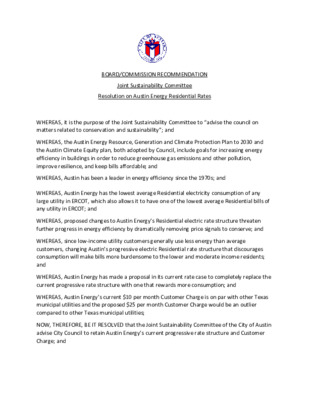Item #5a - Proposed Resolution on Residential Rates — original pdf
Backup

BOARD/COMMISSION RECOMMENDATION Joint Sustainability Committee Resolution on Austin Energy Residential Rates WHEREAS, it is the purpose of the Joint Sustainability Committee to “advise the council on matters related to conservation and sustainability”; and WHEREAS, the Austin Energy Resource, Generation and Climate Protection Plan to 2030 and the Austin Climate Equity plan, both adopted by Council, include goals for increasing energy efficiency in buildings in order to reduce greenhouse gas emissions and other pollution, improve resilience, and keep bills affordable; and WHEREAS, Austin has been a leader in energy efficiency since the 1970s; and WHEREAS, Austin Energy has the lowest average Residential electricity consumption of any large utility in ERCOT, which also allows it to have one of the lowest average Residential bills of any utility in ERCOT; and WHEREAS, proposed changes to Austin Energy’s Residential electric rate structure threaten further progress in energy efficiency by dramatically removing price signals to conserve; and WHEREAS, since low‐income utility customers generally use less energy than average customers, changing Austin’s progressive electric Residential rate structure that discourages consumption will make bills more burdensome to the lower and moderate income residents; and WHEREAS, Austin Energy has made a proposal in its current rate case to completely replace the current progressive rate structure with one that rewards more consumption; and WHEREAS, Austin Energy’s current $10 per month Customer Charge is on par with other Texas municipal utilities and the proposed $25 per month Customer Charge would be an outlier compared to other Texas municipal utilities; NOW, THEREFORE, BE IT RESOLVED that the Joint Sustainability Committee of the City of Austin advise City Council to retain Austin Energy’s current progressive rate structure and Customer Charge; and BE IT FURTHER RESOLVED that if any rate increases are enacted, they be levied as a proportional increase to the utility’s current monthly base cost and tiers in its current rate structure.